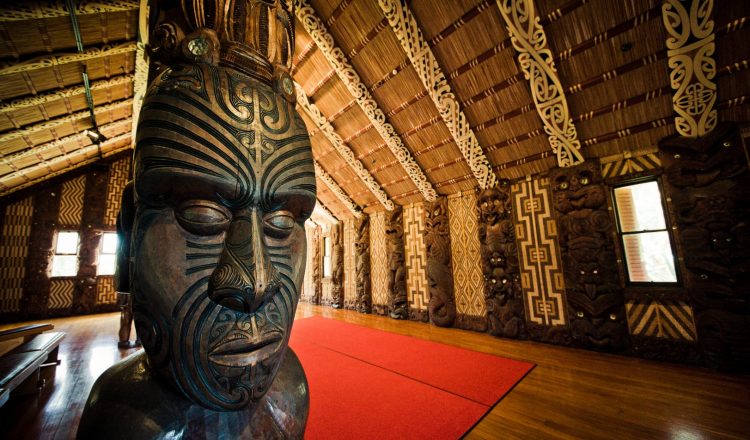Marae: Meeting Grounds
A Place to Stand
A marae is a Maori meeting ground. It usually comes in the form of a fenced complex of carved buildings that belongs to a particular iwi, hapu or whanau. Marae come in different shapes and sizes but are a central part of Maori culture. The marae is a tribe’s turangawaewae or ‘place to stand’, their sacred property that brings the whole group together.
A marae will be the venue for meetings, celebrations, weddings, funerals and even educational workshops. Inside the marae, the carved meeting hall or wharenui will be the main area for these tribal events. They carve the wharenui to resemble parts of a human body, usually that of a tribal ancestor. The carved figure (tekoteko) on the roof at the front of the hall represents the head, and the front barge boards (maihi) show the arms outstretched to welcome visitors. Inside the wharenui, the walls a covered with carvings of stories and legends, with pictures hung of departed loved ones.
Outside of this meeting house will be an open space for outdoor gatherings, a dining hall for the iwi to eat together, a cooking area and toilets. A marae is less commonly used as a permanent living space these days. Still, in the event of a tribal meeting or celebration, it is not uncommon for the iwi to come together and stay communally for a few days in the main hall. With such an emphasis on community, the tribe will eat together, cook and clean as a unit and discuss tribal affairs.
Parts of the Marae
The marae and the meetinghouse are complementary and together serve as the focal point for community sentiment. The meetinghouse is normally the major central building and, in the main, ornately carved. The meetinghouse has many new names including tipuna whare and wharenui. In nearly all cases it is not only named after an ancestor but it is structured to represent symbolically the ancestor. Thus the tekoteko (carved figure) on the roof top in front represents the ancestor head, the maihi (carved angles from the head down towards the ground) represent the arms, the tahuhu or taahu (the ridge pole down the centre of the building) is seen as the backbone and the heke (rafters) reaching from the tahuhu to the poupou (carved figures around the walls) represent the ribs. The poupou are normally carved ancestors representing other tribes. Poupou then function as identifiers in a feeling of belonging. The uprights, normally two holding up the tahuhu, represent connection between Rangi, the sky father and Papatūānuku, the earth mother. While there are other interpretations it follows appropriately that the meeting houses are named after an ancestor. Thus, on entering the house it can be seen as entering into the bosom of an ancestor. It follows also that the interaction between people on the Marae-atea-o-Tumatuenga can be and should be significantly different from the type of interaction, which is normally encouraged inside the house. It is believed that inside the house of Rongo (the God of Peace) reigns and it is in this atmosphere and under this belief that people are required to interact with one another.
The Whare
The Whare Kai his the eating-house. The Whare Kai is a separate, not necessarily as a physical reality but in some cases as a concept or belief. The concept of tapu (sacrosanct) prescribes where food is eaten and where it cannot be eaten and also where drinks can and cannot be drunk. To the Māori, food is noa (a common element) and the opposite of tapu. Whereas the tipuna whare (meeting\/ancestral house) is tapu and food cannot therefore be eaten there, the whare kai is free from tapu – the two are at opposite ends of a continuum.
Other Buildings and Structures
Many marae have churches situated nearby. This is significant in terms of the acknowledgement of God as an ever-present dimension in the daily lives of people on the marae. Many marae also have an urupa (graveyard) nearby acknowledging the ancestor as a living dimension of life. An ancestor is commemorated within a building – respects are paid to those who have passed on the hono-i-wairua (gathering place of spirits) within a whaikorero (formal speech making) reflecting the belief in the merging of life and death that is significant and meaningful for the Māori. Te hunga ora (living people) are the result of a combination of te hunga mate (the dead) and te hunga ora. References to these concepts are very frequent in whaikorero. On some marae memorials to a significant ancestors or people who died in the Second World War are found to the side of the marae or wharenui and in some cases a flag pole stand majestically at the side of the meeting house. Last, but not least, the ablution block and toilets are placed significantly to the rear of the Wharenui and the Whare Kai.
Entering the Marae
If you are lucky enough to be invited to a marae as a guest, you must first be welcomed officially, in a ceremony known as powhiri. This welcome consists of many different phases but once completed; you will be allowed to enter the tribe’s space. Basic etiquette around a marae is always to be respectful and ask permission before taking photos. You should remove your shoes when entering buildings and don’t eat or drink in the wharenui. The powhiri is a ceremony that involves singing and dancing (like the famous haka), try to remain expressionless and receive the honour graciously.

















































